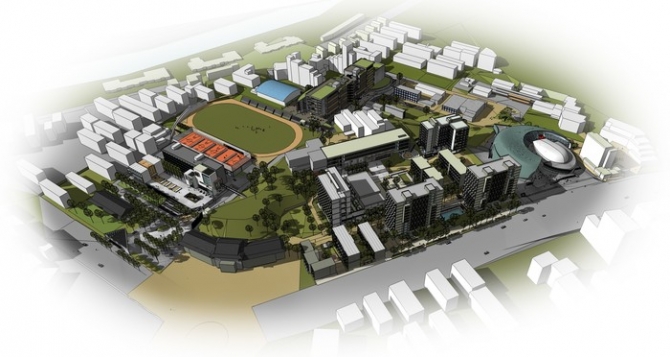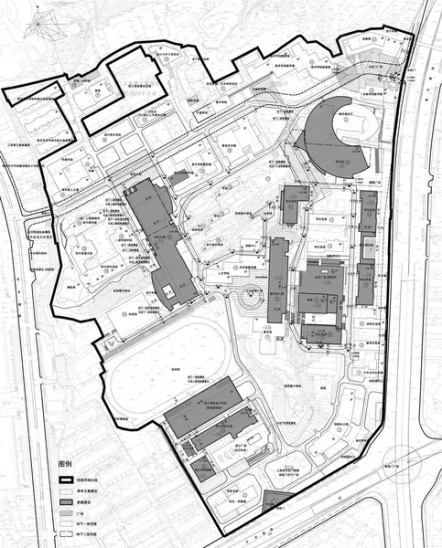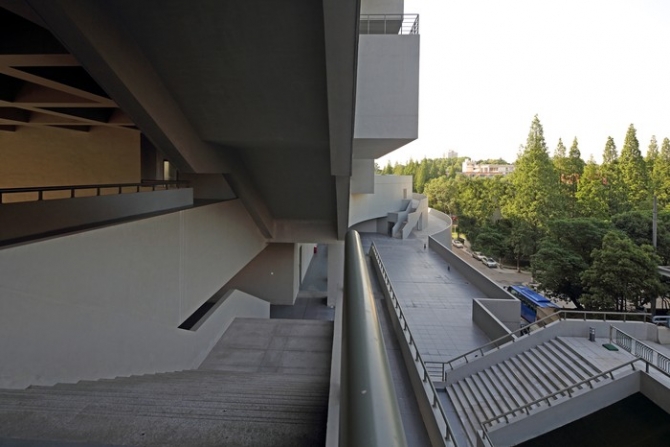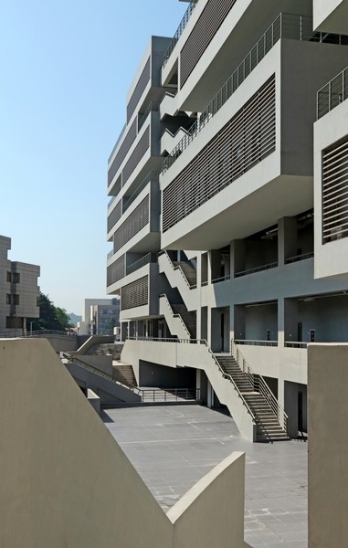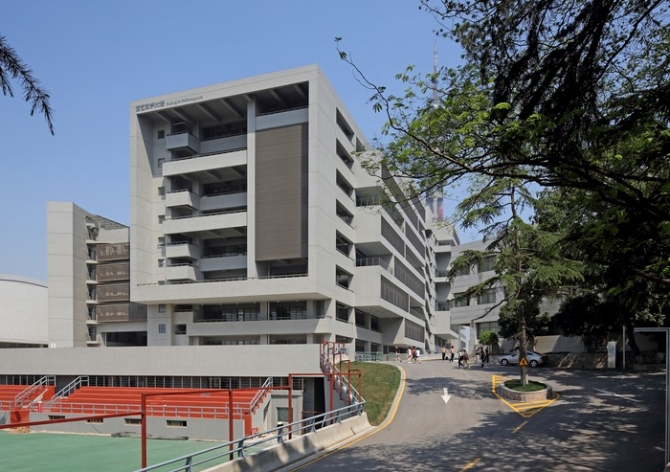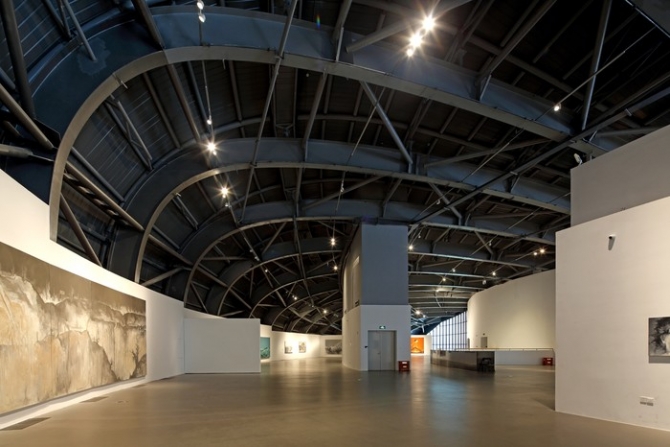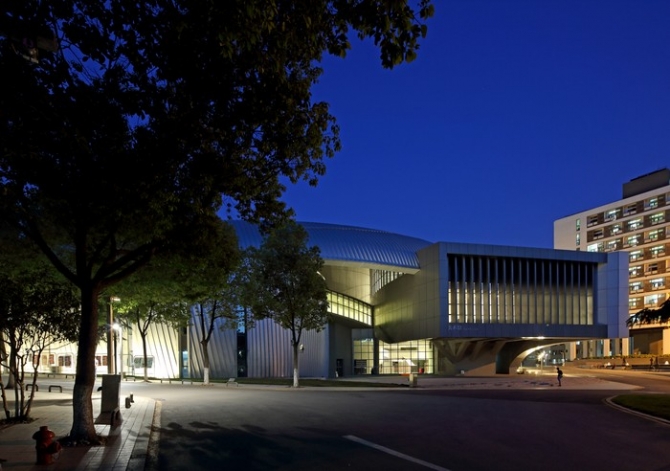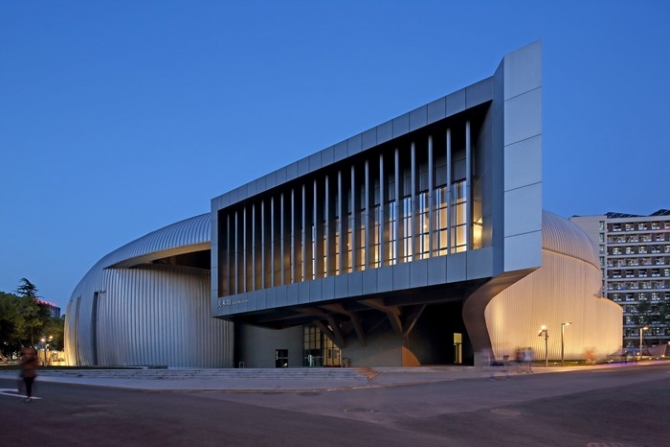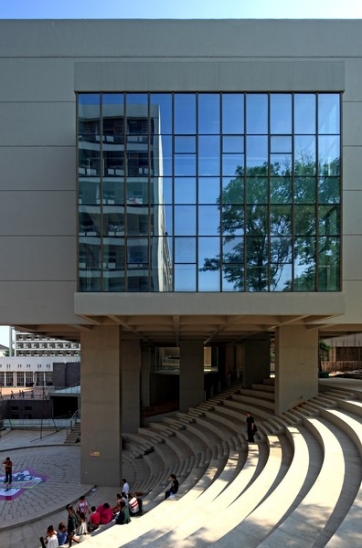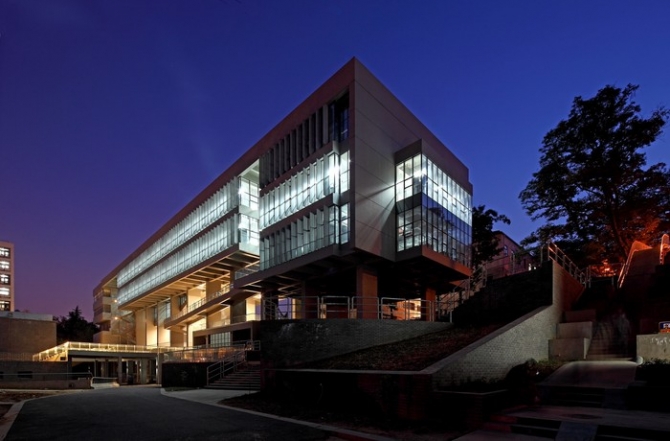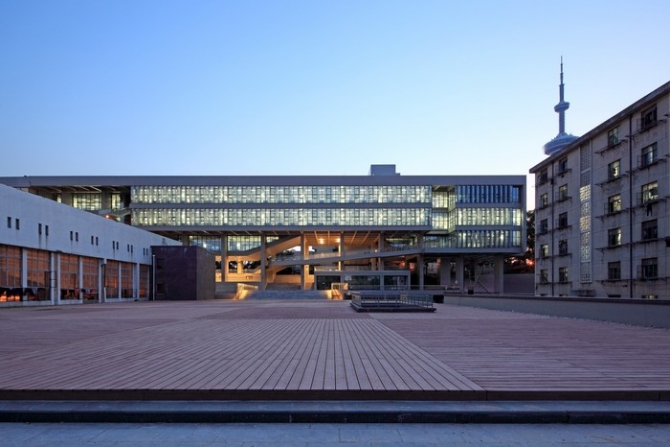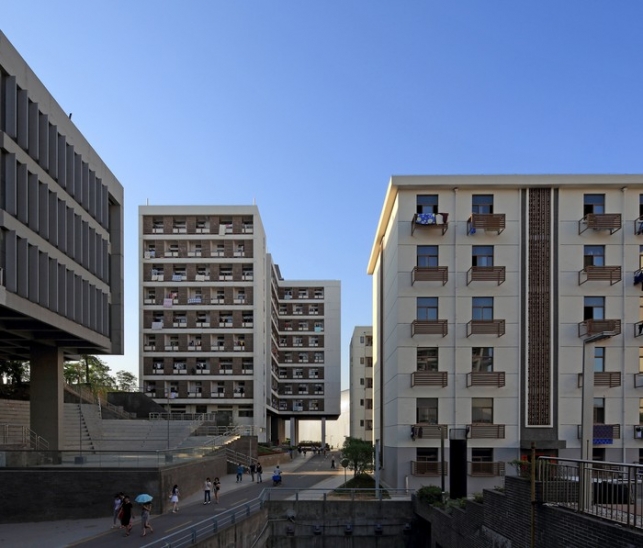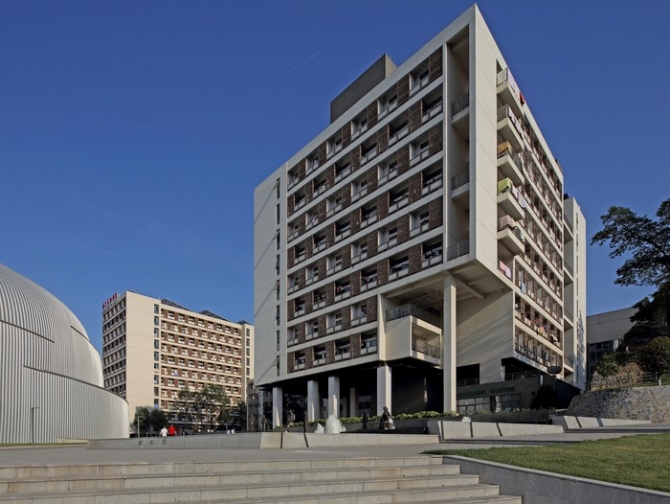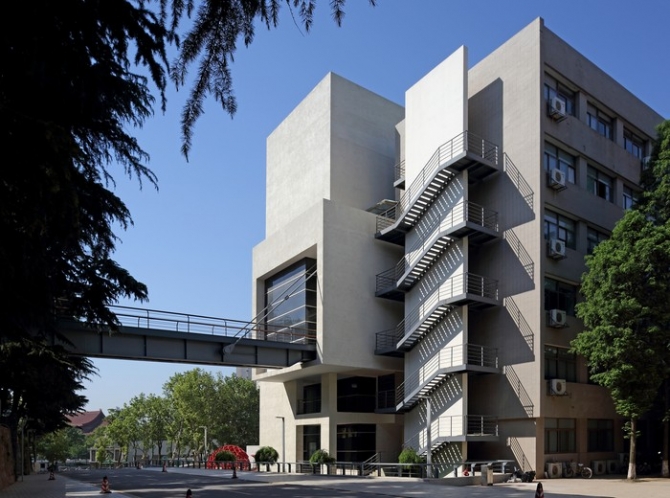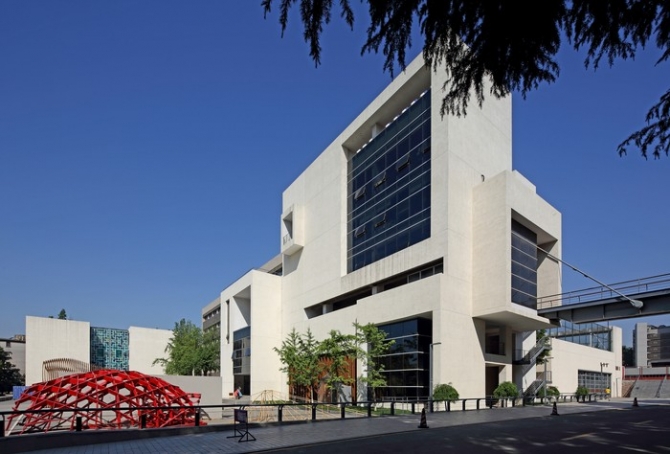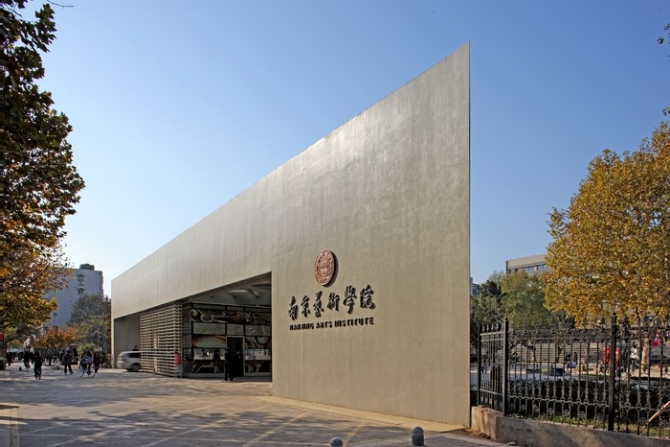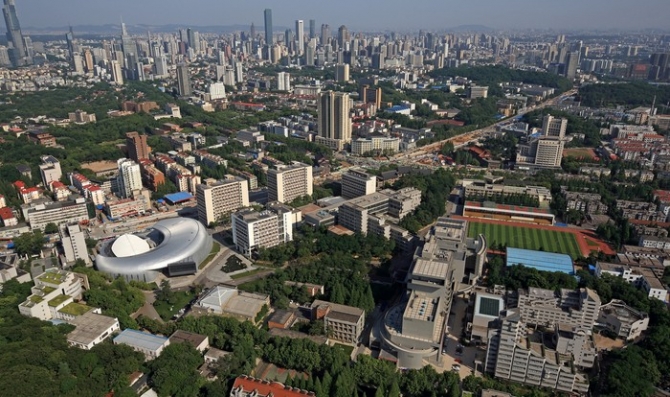南京艺术学院改扩建项目Art Gallery and Performance Center of Nanjing Arts Institute
1、作为对原工程学院主楼的改造和扩建,项目需要营造适合设计专业特点的教学与艺术创作空间,同时利用原有地形特点,解决南校门的交通、停车等功能问题。
三角形的校门应对了城市道路和校园建筑之间的夹角,强烈暗示了朝向北侧山体的空间引导性,与复建的原上海美专校门遥相呼应。校门造型简洁,屋顶为透空格梁,坚实的外框内含精巧的玻璃传达室,其幕墙彩色艺术玻璃为校方设计制作。正对校门的大台阶将位于不同标高的校门广场和设计学院广场连成一体,串连整个步行区。利用地形高差增加的可自然通风、采光的半地下车库及小型下沉庭院,活跃了广场气氛。
设计将两栋原主楼、配楼建筑连通,分别容纳教室及展厅。设计拆除主楼西墙的墙裙,植入了空调系统,用铝格栅延续原有的立面外型。主楼东南角加建六层高的教学房间,各房间根据尺度不同可用于展览、教学、会议、制作、休息等用途,成为一座具有提示作用的艺术墙面。建筑东侧出挑一部钢桥,与东侧山体步行道相连。新老建筑之间形成狭长的缝状中庭,空间变化丰富,成为最具活力的交往、活动空间。
1、The genesis of this renovation arose from several aspects. First, the original teaching buildings need to be remodeled as a place which cloud enhance imaginative atmosphere. Second, the alternation must follow the topographic character of the campus. And the third aspect, resolving the existing functional problems, such as the chaos of traffic and the lack of parking, is also required urgently.
A triangular porch indicates the angle of the city road and the spatial axis for a restored school gate, which has a history ascending back to 80 years ago. The sculptural massing contains an ingenious reception office, which is clad with stained glass window designed by students of the Arts Institute.
Two of the old buildings are connected to house classrooms and exhibition halls. Destroying the west bottom wall, embedding an air condition system, adhering the aluminum lattice to maintain the original form of the building, and adding several vertical stacked classrooms on the southeast corner, the designers change them into a cluster of containers, which can be employed for exhibition, teaching, meeting, manufacturing and resting. Through a steel bridge on the east, students could access the lane on the east hill. Between the old and the new building, a narrow atria full-filled with various space elements provide opportunities for students and faculty to meet and communicate.
2、为满足学生宿舍的需求量,在狭小用地内新建的四栋宿舍楼均为板式高层,它们共同围合出内聚性的空间,并通过保留原有大树,底层架空,减少对环境的压迫感。架空层内设有茶吧、洗衣房、管理室、小超市等服务功能,地下为半开敞的自行车库。通透的廊道围合出庭院,也成为通往校园公共空间立体步行系统的一部分。宿舍外错落的公共平台创造了更多交往的机会,外阳台和两间共用一套的卫生间则确保了学生的生活质量。
2、To accommodate a large number of students, four students’ dormitories are inserted into a narrow slope. They enclose the quadrangle, providing place for tea bar, laundry room, management office and small supermarket on their semi-opened bottom floor. The twisting colonnade between them also becomes a part of the whole pedestrian system of the campus. Platforms on each floor also act as the communication space for students. In addition, each dormitory has a balcony and clotheshorse and two dormitories share a toilet, for the purpose of improving the life quality of students.
3、在老校区内进行更新改造,设计的原则是“见缝插针,左右逢源”。图书馆新馆需要贴临老图书馆接建,身处现状食堂与教学楼之间的狭长地带,又恰好位于山坡的边缘,地势高差超过10m。
设计将整个建筑上部抬起,下部沉入坡地,中间架空两层,仅有门厅与上部几层与老馆联通,并在尺度上与老馆取得一致。大跨度柱廊下的层层台阶和坡道,形成一条丰富而有趣味的通道,便于生活区和教学区之间的步行往来,持续强化了校园位于坡地的特点。新馆立面满铺竖向遮阳百叶,不仅使建筑体量显得更为轻巧,使阅览室内的光线更加柔和,更对形成校园的这一处公共空间的完整性,主导建筑群落之间简约利落的整体风格起到了关键作用。
3、As a rebuilding project in old campus, the new part of the library need to be closely connected to the old part, which is located in a narrow area in between a dining hall and a teaching building. The site happens to be at the edge of a steep hillside with a height difference larger than 10m.
The upper part of the library is lifted up, while the bottom sinks beneath the ground. Two floors in the middle are almost opened to outside, only the entrance hall are set here for the arriving of upper levels. The level height, façade proportion and scale of the new built part are derived from the original part. Stairs and ramps are organized as an interesting walk way, which connects the dinning hall and the teaching building and emphasizes the topographic feature of the campus. Vertical sun-shades of the facades made the building looks lighter and softened the sunlight in the reading room, and contributed a lot in the formation of a contracted style.
4、演艺大楼位于校园一处狭长的南北向用地上,地势高差约12m,周边房屋密集。其形态来自设计应对环境的策略,与现状建筑在尺度和空间上寻找关系并实现了协调。在满足功能和面积需求的前提下,设计尽量限制地面以上的建筑体量。结合地势将不同功能的入口设于不同楼层上,所形成的入口广场同时承担了衔接地势,加强南北校区联系的功能。为避免过长的建筑体量成为东西向视野的阻挡,建筑中部断开并加以削减,在三层入口形成景观视线通廊。横向坡道形成环廊,解决了高差问题,并连通各层内廊,提高了走廊使用率。所有练琴房均有自然采光,不需要自然光的大空间排演厅等则设于平面中部及地下。建筑立面是对内部空间的真实反映。东西向外廊采用成排通透的百页阵列;面宽不一的外挂琴房使得立面开窗和空调室外机格栅产生跳跃的节奏感。格栅、开敞平台与半敞开外廊等形成了既有规律又充满变化的组合,并与剧场区大面积的清水混凝土墙面形成对比。
供四个学院使用的排练厅、演奏厅、观演厅和琴房对高度、面积的要求各不相同,要在有限的体量内塞进数量和种类繁多的房间,经过错综复杂的排列组合,以平面上6m、11.2m和8.4m的三联柱跨,配合2.6m、3.9m、4.2m、7.8(3.9×2)m和8.4(4.2×2)m五种层高的复杂搭配,得到了从 4m2到400m2不等的近600间琴房和上百个无柱的排练、表演和教学房间。
4、As an insertion to such a dense built area, the performance building is considered to be a coordinator for the existing buildings and a connection for two originally separated campuses. Building configuration derives from the strategy answering its environment in scale and in reconstruction of public spaces. Under the promise to satisfy functional requirements, the mass above ground is minimized. The 12m height difference of the narrow site is exploited for disposing entries of different functions on different levels so that to shape a few entrance squares for the building itself and its neighbors. To avoid blocking the east-west-direction views in the campus by such a long building, the central part is cut down. Ramps, stairs and platforms form an outside loop system to accommodate the complicated height difference. Every music room owns natural lighting, while those large scale rooms for rehearse or performance are set in the central of plan or underground. The appearance exactly represents the space organization. The outside loops are wrapped by louver boards and the different widths of rooms give the façades a rhythmic atmosphere. In contrast to the large solid concrete wall of auditorium, the louvers, platform and side corridors produce multi-layered effects.
After a painstaking arrangement process, more than 600 music rooms, a lot of rehearse halls and an auditorium is filled into the limited volume. To satisfy the different required sizes, heights and positions, the spans of the plan are decided to be, in order, 2.6m, 3.9m and 4.2m, with 5 different floor heights, 2.6m, 3.9m, 4.2m, 7.8 (3.9×2)m and 8.4 (4.2×2)m.
5、南京艺术学院美术馆的建设基地紧邻原有的音乐厅。为了化解紧张用地内增加新建筑的矛盾,同时对音乐厅不完整的形式进行修复,设计柔化了美术馆的形体,以向心的弧形体量与椭圆形音乐厅扣合在一起,形成紧密的“共生体”。美术馆的机房部分被埋入地下,释放其屋面形成一个面向街道的艺术广场,为城市提供了具有凝聚力的公共空间。除了面向城市的东侧主入口,面向校园的西侧设有供师生使用的次入口,北侧则为独立的办公区。美术馆的主要展览区通过坡道连接,参观者可以在观展过程中体验不同空间的转换。疏散楼梯、通风管道等辅助性功能集中在中央的混凝土核心里,确保获得无柱的展厅。
向心的弧线形体对音乐厅形成半围合之势,完整、流畅,富于视觉冲击力,有助于强化识别性,确立这一公共建筑作为城市地标的特质。在经过整体规划、改造从而实现建筑与外部空间有机复合的校园空间内,这一点睛之笔起到活跃整体空间的作用,其浑然朴拙的形象也成为校园街道和广场所见精彩的视觉底景,表现出美术馆独特的艺术感染力。
5、Encircling the already built concert hall, the gallery of Nanjing Arts Institute is actually designed as a complement for the former one. It not only indicates the centripetal arc shape is a perfect counterpart of the oval pavilion, but also emphasizes that the roof of the gallery’s underground equipment rooms between them, becomes an attractive urban space and joints the two buildings cohesively. Since the east side with main entrance is designed for citizens, a campus entrance is opened on the west side as well as the north part of the building is an individual office area. Ramps connect all the exhibition spaces to provide visitors a continuous and unique experience sequence. To guarantee the column-free space effect, all the emergency staircases, ventilating pipes and other auxiliary functions are gathered into the central concrete core.
Effortlessly, the building turns into a focal point of the community by its remarkable fluent figure. For the organically organized campus, it also acts as a catalyst for activating the whole space structure. Its powerful image becomes the end of the view corridors of public spaces in the campus.
项目地点:江苏省南京市
建筑面积:
设计学院及南校门:14909㎡
学生宿舍:9424㎡
图书馆:9956㎡
演艺大楼:43062㎡
美术馆:12715㎡
设计时间:2007年
建成时间:2012年
合作建筑师:张男、时红、刘新、买有群、何理建(Christian Hennecke)、赵晓刚、王可尧、叶水清、董元铮、高凡
施工图配合:深圳华森建筑与工程设计顾问有限公司南京分公司

